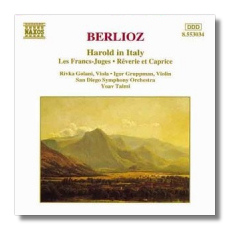
The Internet's Premier Classical Music Source
Related Links
- Berlioz Reviews
- Latest Reviews
- More Reviews
-
By Composer
-
Collections
DVD & Blu-ray
Books
Concert Reviews
Articles/Interviews
Software
Audio
Search Amazon
Recommended Links
Site News
 CD Review
CD Review
Hector Berlioz

Orchestral Works
- "Les Francs-Juges" Overture Op. 3 (1826)
- "Harold in Italy" Symphony for Viola and Orchestra Op. 16 (1833)
- "Rêverie and Caprice" Romance for Violin and Orchestra Op. 8 (1841)
Rivka Golani, viola
Igor Gruppman, violin
San Diego Symphony Orchestra/Yoav Talmi
Naxos 8.553034 - 63min
For what it is worth, I used as references Leonard Bernstein's recording with the Orchestre National de France (EMI 7 64745) with Donald McInnes on viola, and Colin Davis' with the London Symphony (on Philips 416431) Nobuko Imai soloist.
It is a pity that this disc represents the penultimate recording of the San Diego Symphony. Just this year the orchestra folded for lack of funds. Having been a professional orchestra for over 65 years it is a shame that the city of San Diego could not have found a way to preserve this excellent orchestra. Based on what I heard, the San Diego Symphony was as good as any in this country and better than most. So it goes.
This recording quickly went to the top of my list of favorites. It is a fine performance, making the loss of this orchestra even more painful. They play with an uncanny idiomatic flavor. Golani has a tone that is silky, lovely, and seductive. I am interested in hearing more from her. This Harold seems to steal into the room, the orchestra providing a rich tapestry of sound to underline the soloist. On the other hand, the performance is not lethargic. In fact, as timings go, it is faster than the other two recordings. What we have here, in the first movement, is, as it is labeled, an Adagio. The recording offers a pleasant back-to-front perspective with the listener sitting about midway in the hall. There is just the right amount of reverberation, giving the whole recording a warm atmosphere. As I listened I realized I was having a first hearing, even though I've had the other recordings in my collection for some years.
How does it compare with the heavy guns of Bernstein and Davis? Well, in one sense there is no meaningful comparison. Bernstein and McInnes imbue the piece with much more drama, underlining moments, making gestures that imbue the piece with a Fantastique atmosphere. McInnes' viola is more plaintive in tone. The EMI recording is just slightly dryer, producing somewhat clearer detail. The harp, for instance, is more clearly delineated in this recording. I appreciate this kind of interpretation, but it is so different from the San Diego recording that no real comparison is possible. The Colin Davis is slightly self effacing compared to the Talmi interpretation. That is not in Davis' favor. The Naxos recording and performance has more character, by comparison Davis is directing traffic.
The other Berlioz pieces? Well, I do not have any comparisons, though I did listen to Previn's recording of Les Francs-Juges and the Naxos wins hands down by comparison. The Rêverie is a beautiful nocturne-serenade-like piece with the soloist and orchestra working together like lovers. They add to the total time of 62:47 and it is good to have them. They have all the Berlioz flavor and signature.
The insert notes about the music are a refreshing change to the general clap trap that seems to be the norm in such writing today. Dr. Charles Barber's comments provide the tyro with a general discussion of the music, piece by piece, movement by movement. There are also biographical details about the soloists and conductor. Sadly, there is also a discussion about the orchestra which almost, ironically, serves as an obituary.
I think I will be listening to this disc more as time goes by. While I am not sure I prefer it over the Bernstein, it is an excellent, lovely performance. Think I'll go enjoy it some more.
P.S. In the midst of writing the above, I noticed that the November issue of Gramophone had a review of this same disc written by Edward Greenfield. I made a conscious effort to not read it before writing the above and succeeded. I have to say that you really ought to read it because he expresses reservations about the disc for some of the very reasons I praise it. Specifically, he damns the sound as having sabotaged the performance. I respect and have long admired Edward Greenfield's opinions and do not want to debate them here (if anywhere). On the other hand, I respectfully disagree with his opinions.
I have listened to this Naxos disc several times. You really do need to crank the volume to get the same dramatic effect as in the Bernstein. However, once you do you will hear an almost equally impressive recording. Regardless of recording venue and recording techniques, Bernstein's attacks are sharper. On the other hand, the Naxos recording is warmer and does not tire the ear. I had the opportunity to talk, briefly, with two of the producers of this disc. I am going to write a more detailed "interview" about their work. Victor Ledin, however, did tell me that they use tube recording equipment and large microphones, not some of those 'skinny things' often employed today. More later.
Copyright © 1997, Robert Stumpf II


















